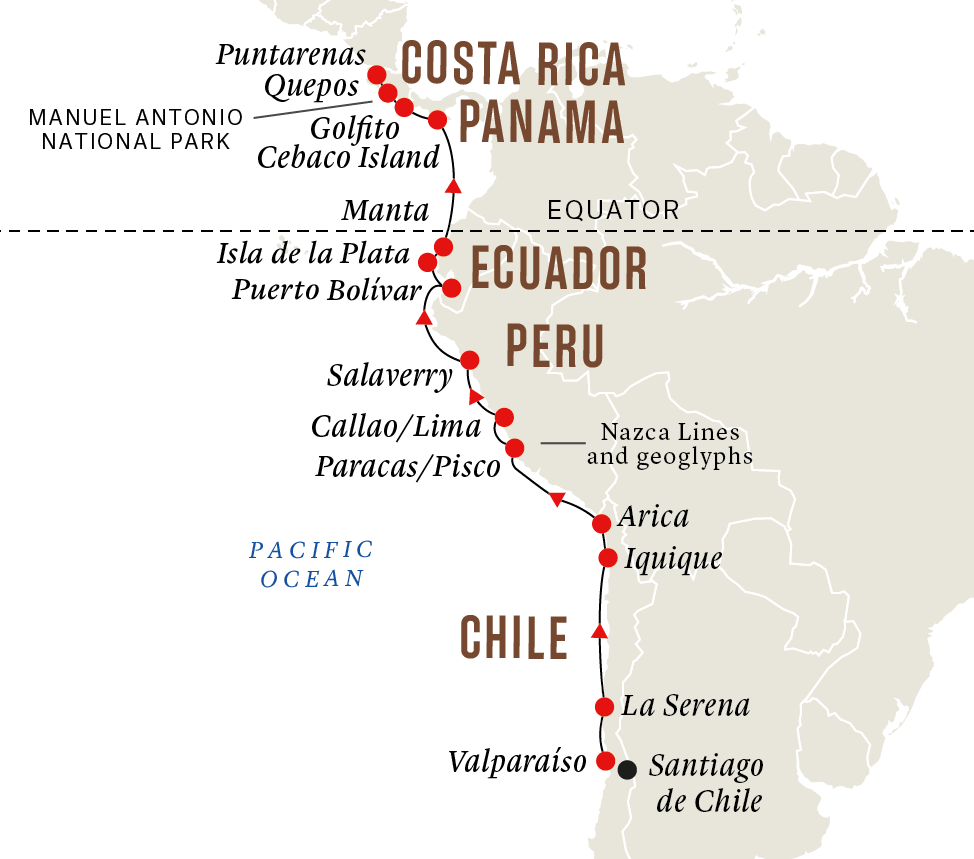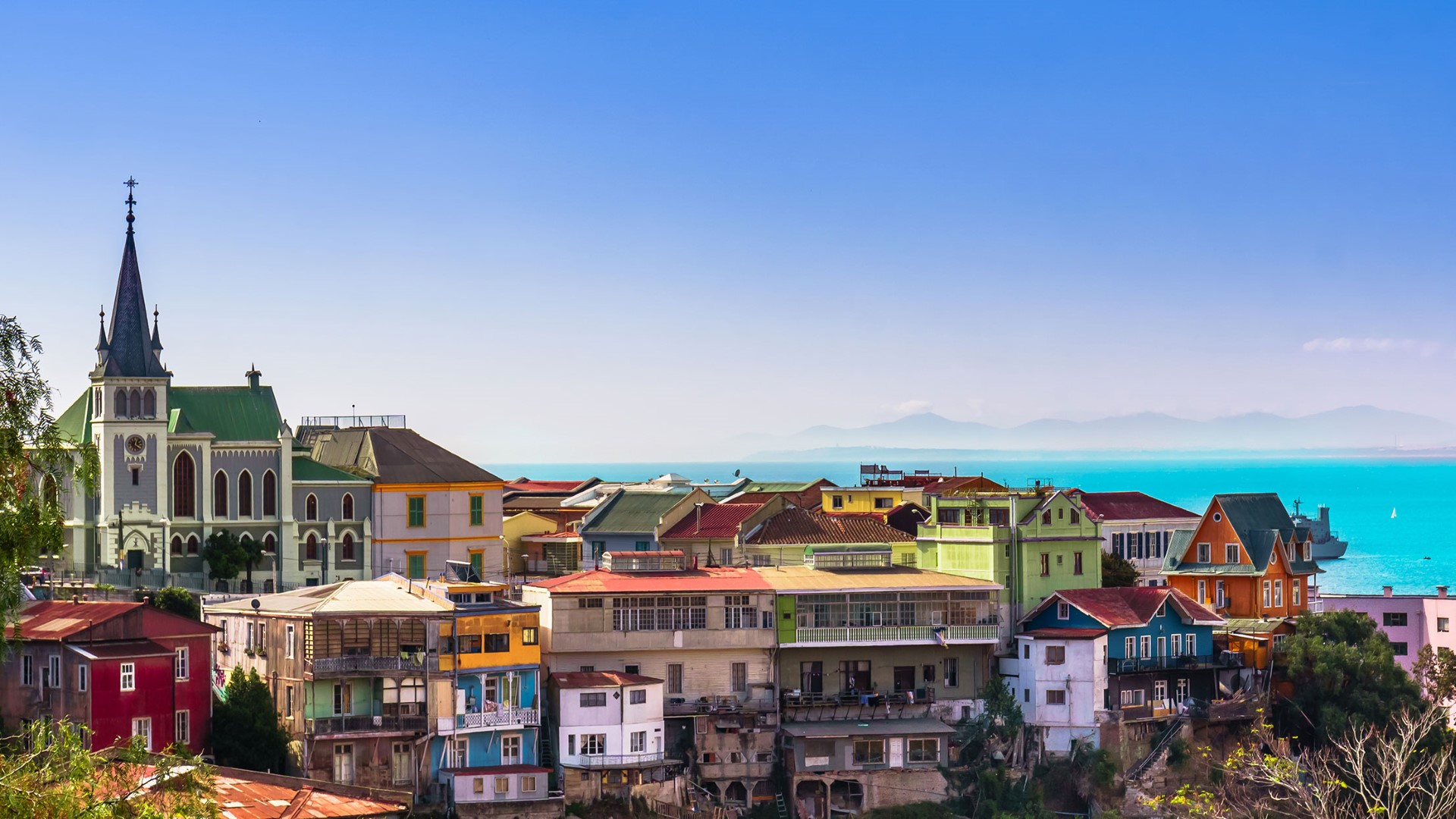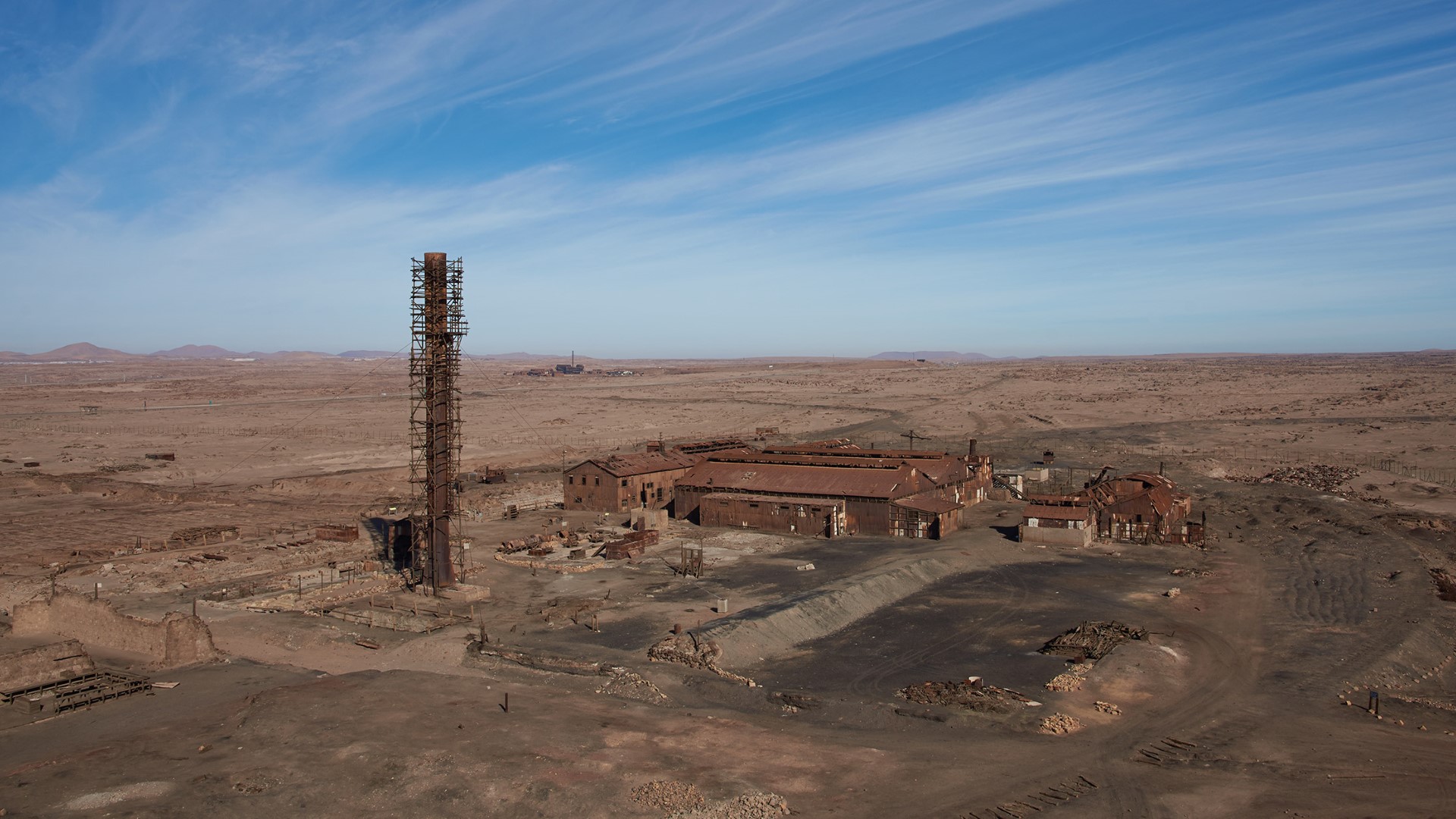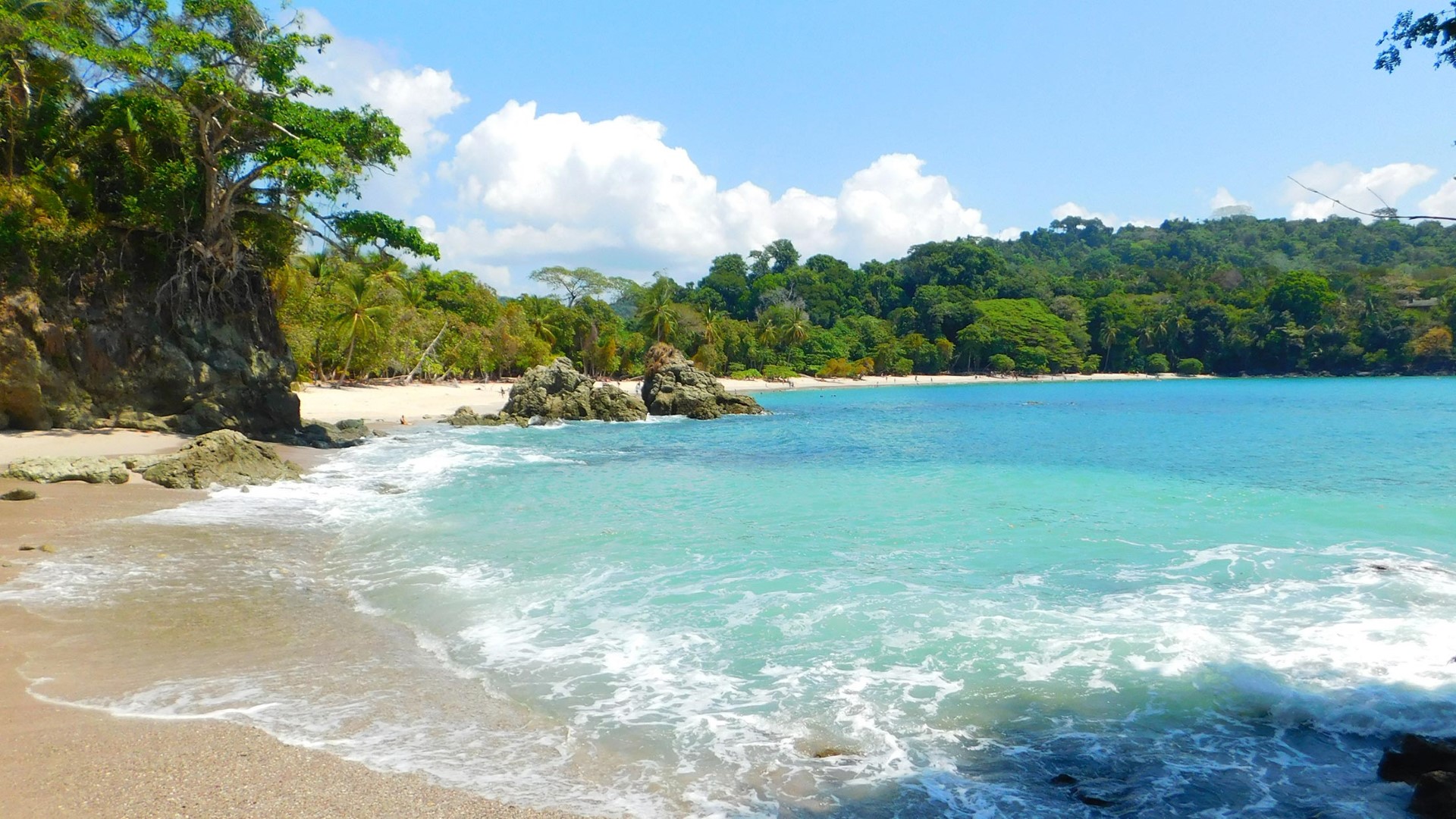Diverse Cultures and National Parks of Latin America
CAD $TBA
18 days / 17 nights
This expedition from Chile to Costa Rica explores five Latin American countries, uncovering ancient pyramids, exceptionally beautiful national reserves, and delicious local delicacies.
Itinerary
Our hybrid electric–powered expedition ship MS Roald Amundsen will be waiting for you in Valparaíso in central Chile. Built on steep hillsides overlooking the ocean, this UNESCO-listed city is a maze of monuments, churches, historical funiculars (cable cars), trendy neighborhoods, cobblestone alleys, colorful houses, and charming plazas. Cerros Alegre and Concepción have arguably the best views, while the historic port district boasts colonial architecture, bustling mercados, and the maritime and modern art museums. You also have the option to
Once you board the ship, you can pick up your complimentary expedition jacket, settle into your cabin, explore the ship, and attending a mandatory safety drill. After the welcome dinner (featuring a toast by the captain), you’ll meet your Expedition Team, who will run through important health and safety aspects with you.
Perched on terraces above the ocean, La Serena is blessed with beautiful sandy beaches all along Avenida del Mar and beyond. You’ll find that Chile’s second-oldest city has a distinct and purposefully crafted Neo-Colonial look and feel to it. Its modern buildings meld with buildings of an older vintage, such as the 30 or so carefully restored stone churches, some of which are 350 years old. These charming churches may look similar to one another, but you can distinguish them by their different styles of belfries.
Aside from wandering the beaches, promenades, and plazas, you can also stroll through manicured public gardens such as the Japanese-inspired Jardín del Corazón or shop for handicrafts at Recova Market. Admire pre-Colonial artifacts at the archaeological museum or head to Patio Colonial, near Balmaceda, for casual cafés and eateries.
Enjoy the serenity of this day at sea. Relax and admire the scenery from the observation deck or from the lounge.
Throughout your journey, the Expedition Team will give lectures in the Science Center and share their extensive knowledge of the region. Topics may include periods of pre-Columbian history, the geology of the surrounding mountains and islands, the folklore of the local communities, and much more. Not all of our lectures are indoors, though! If curious seabirds come fly alongside the ship, the Expedition Team might also help you spot and identify them from the deck.
Welcome to a slice of paradise by the Pacific, complete with palm trees and promenades. As one of Chile’s top seaside cities, Iquique is buzzing with activity all year around. Shoppers stream to the duty-free Zofri Mall, while ship enthusiasts will love the tour of La Esmeralda, a steam-powered warship used and sunk during the War of the Pacific. You might have the opportunity to visit the nearby abandoned saltpeter mining town of Humberstone in the Atacama Desert. This UNESCO World Heritage Site is a slice of history that you can literally walk through.
Back in Iquique, stroll the La Costenera boardwalk next to Playa Cavancha and admire the city’s skyline on one side and the parasailors and surfers on the other. Baquedano Street showcases 19th-century Georgian architecture and leads to Astoreca Palace. Don’t miss the photo op at the clock tower, located in the town center. You’ll pass an array of chic cafés, where you can indulge in local coffee culture or sip a traditional creamy mango sour. You’ll find Iquique’s Chinatown near the mercado, bringing with it the unique ‘chifa’ cuisine, which marries Peruvian and Chinese flavors. Aside from the wide range of seafood dishes, you’ll definitely want to try chumbeque, a dessert that features a cookie sandwich coated with an anise-flavored syrup.
Arica enjoys a constant desert climate, which is atypical for a city by the sea. In fact, it is even one of the driest cities in the world. This also means that it is bathed in glorious sunshine almost every day of the year, and residents proudly describe Arica as being immersed in a never-ending spring. The beaches are popular with sunbathers and surfers alike. The 15-minute hike to the top of the tall, sandy El Morro cliff is well worth it. Once you find the fluttering Chilean flag on top, you’ll also be rewarded with great views.
Another hotspot for visitors is San Marcos Cathedral, designed by Gustave Eiffel (of Parisian fame) and inaugurated in 1876. Calles 21 de Mayo and Bolognesi are lively pedestrian areas filled with eateries and artisan stalls, while the El Agro market and food court is full of sights and scents. At the San Miguel de Azapa Archaeological Museum, peruse artifacts from Chinchorro culture and marvel at mummies who are older than even the ones found in Egypt. Head to the south of the city to trek the more rugged Playa Corazones and explore Cuevas de Anzota (the Caves of Anzota). You also might have the opportunity to go on an optional excursion to see geoglyphs in Lluta Valley and Lauca National Park.
As we sail northward toward Peru, continue to enjoy the Expedition Team’s lecture program. On deck, a healthy salt-tinged breeze and magnificent views will invigorate you, as well as all the facilities the expedition ship has to offer. These waters are part of the Humboldt Current, a cold-water current that cools the climate in the region and causes clear blue skies. It also sustains the region’s highly productive marine ecosystem, causing large quantities of sardines, anchovies, and mackerel.
If you’re someone who likes to keep active, there are well-equipped gyms on board, both indoor and outdoor and each with great views. Swimmers should be excited too—the ship has a heated infinity pool for you to enjoy. If you get tired of the treadmill, move your stride over to the outdoor running track. The scenery and the sea breeze might just inspire you to stretch your run out for a few more miles.
Nestled on a bay behind a peninsula, the humble and sleepy resort town of Paracas is surrounded by brown-sugar–colored cliffs and beaches. Known to most as ‘El Chaco’, the town’s main shorefront and boulevard features a wide array of restaurants where you can taste jalea, a mix of fried seafood with salsa criolla (Creole) and yuca root. Another specialty is Peruvian silverside fish, known as pejerry, best washed down with a glass of pisco, a grape brandy produced at several of the region’s distilleries. Be careful though, pisco can pack a punch!
Opposite Paracas harbor is the mysterious local geoglyph of a candelabra, which may date as far back as 200 B.C. It could be related to the famous Nazca Lines, which you can visit in the Pisco Valley. This optional excursion is just a short drive south. The Nazca Lines could be older than the candelabra, but new ones are still being discovered. Could these be extra-terrestrial in origin? You decide.
You may also have the opportunity to take a boat tour of the nearby Ballestas Islands. The Ballestas support a wide range of wildlife, including Humboldt penguins, turtles, Peruvian boobies, cormorants, pelicans, sea lions, dolphins, Inca terns, and humpback whales. Nearby, you can also find Paracas National Reserve, whose territory includes a rare combination of desert and marine ecosystems. The Martian-like yellow dunes and red-sand beaches hide more than 100 archaeological sites of the Paracas culture. They also host excellent views of birds such as the Andean condor and Chilean flamingo.
Set on a strip of desert between the Pacific Ocean and the Andes Mountains, we find the capital city of Lima, served by the Callao seaport. Lima is the country’s largest city, and it is a modern, sprawling metropolis where traditions and trends converge in an exciting cocktail of culture and cuisine.
The UNESCO World Heritage historic center is full of colonial-era architecture such as Plaza Mayor and the San Francisco Monastery. On the other hand, the clay ruins of the Huaca Pucllana and Huaca Huallamarca ceremonial pyramids are remnants of a long-lost Incan civilization. To learn more about pre-Columbian archeology, there are at least four separate museums to pick from. Arty types among us will enjoy the bright and creative area of Barranco, complete with murals, cafés, and two of Lima’s contemporary art museums.
Some say the very best of Lima revolves around its food. Cuisine from the capital has made a splash the world over. Be sure and try this cuisine in one of the many internationally recognized and award-winning restaurants. One of Peru’s all-time gastronomic greats is ceviche, fresh fish marinated in tangy lime juice and other seasonings. This staple dish can be savored in many locations around the city, from upscale diners in Miraflores to salt-of-the-earth cevicherías at the fishing docks over in Chorrillos.
Pummeled by the Pacific’s wind and waves, Salaverry can be a hard port to access. If we are able to land there, though, it will be a good starting point to explore Trujillo, Peru’s third-largest city, and the array of archeological sites scattered throughout the region.
Trujillo sits in a fertile valley oasis irrigated by the Moche River. It boasts a colorful Baroque 17th-century cathedral, 10 colonial churches, and many Neoclassical mansions, not to mention one of the longest mosaic murals in the world at the local university. It’s more likely, however, that your focus will be further back on the past.
The city of Chan Chan was created by the Chimú Empire, which appeared in the region around 900 A.D. The vast ruins of the complex, measuring almost 8 square miles, include the Tschudi temple-citadel and Huaca Esmeralda. On the other side of Trujillo are you’ll find the Mochican pyramids of the Sun and the Moon. These pre-date Chan Chan by a few hundred years! Huaca del Sol stands out as the largest adobe structure on the continent, while Huaca del Luna is a more detailed specimen, with many of its pastel frescos still visible.
As we leave Peru behind and set sail for Ecuador, enjoy another day at your leisure aboard the ship. Take advantage of the many onboard facilities and join in on lectures as we prepare you for what’s to come.
There’s no better place than the Wellness Center to fully relax during your downtime on board. Feel the knots in your muscles disappear during a massage or pamper yourself with a skin-scrubbing treatment. And if the warm weather hasn’t opened up your pores, a session in the sauna is sure to do the trick. You can also slip on your bathing suit and soak in one of the outdoor hot tubs or bask in a state of zen during a guided meditation class. Whatever you decide to do, there are plenty of ways to keep yourself entertained—and ready and revitalized for your next adventure!
Machala’s main claim to fame is Puerto Bolivar, an important Ecuadorian port where coffee, cocoa, shrimp, and bountiful bananas (which the locals call oro verde, or ‘green gold’) leave for export. As part of one of our optional excursions, you may have the opportunity to visit a local banana plantation, or try and spot hummingbirds, parakeets, and howler monkeys in Buenaventura Nature Reserve to the south. The nearby Puyango Petrified Forest has one of the largest collections of fossilized trees in the world, thought to be about 100 million years old—as old as the Andes Mountains themselves.
Feast on fresh seafood at Puerto Bolivar at one of the harbor’s many restaurants and enjoy views of the natural mangrove swamps of Isla Jambeli. Machala has all the charm you’d expect from a small coastal city. Stroll through quaint plazas, admire unusual monuments dedicated to sorting fish and bananeros, and maybe even meet some friendly locals. The restaurants here are evolving and have started dabbling in the hip, modern cuisine for which Ecuador and Peru have increasingly become known.
Isla de la Plata is a part of Parque National Machalilla, Ecuador’s only coastal national park. The island sits a ways off the coast and is prone to large waves that can make landings a challenge. Its nickname of ‘Silver Island’ is thought to come from the belief that English seaman Francis Drake buried a treasure trove of silver here. It could also come from the copious bird guano reflected in the sunshine, giving the island a shiny, silvery look when seen from the mainland. Unfortunately, no treasure has ever been found on the island, which is just over two square miles in size.
But what the island lacks in size or silver, it more than makes up for in the wide range of wildlife, even rivaling that of the Galápagos Islands. If we are able to land here successfully, keen birdwatchers take note! Have your binoculars at the ready to spot some of the 32 species of birds found here, including the famous blue-footed boobies, nesting waved albatross, pelicans, gannets, and frigate birds. The wildlife in the island’s waters are equally diverse. Keep an eye out for whales, manta rays, green turtles, and dolphins.
Manta is a bustling and prosperous port city with high-rise buildings, resort hotels, and several casinos. It is well-known for its long stretches of beach whose blessed wind and waves draw surfers, body-boarders, and kitesurfers from across the globe. You can mingle with casual beachgoers at the shops, restaurants, and bars of Malencón Escénico at Playa el Murcielago. You can also head to San Lorenzo for surfer-sweet swells or go to Playa Bonita at Santa Marianita to watch kitesurfers take off from the sea into the sky.
Aside from tourism, the city’s tuna fishing and canning industry is a successful and key industry here. As is typical for a coastal city, seafood is the specialty on the menu at most restaurants in the area. Try succulent wild-caught shrimp, black clams, octopus, red snappers, and much more. Make a point to try a bowl of the local encebollado broth made with fresh tuna, the pride of Manta. The Museo Municipal Etnografico Cancebi showcases Ecuadorian art and artifacts from the local pre-Columbian civilization, including ancient fishing tools. You may also have the opportunity to visit the nearby town of Montecristi, famous for handicrafts, and where traditional Panamanian straw hats were first created and still hand woven to this day.
A day at sea means the opportunity to attend interesting lectures, learn basic expedition photography, try your hand at an art workshop, and enjoy the fresh sea air out on deck as you watch for wildlife. You can also use microscopes in the Science Center to analyze samples taken during the cruise. As we cross the Equator, it’s the tradition of Norwegian sailors to hold a ceremony to seek King Neptune’s blessing. If we’re in luck, he may even make an appearance.
By this stage of your journey, you can now regard your fellow explorers as friends, after finding so much in common in your interests and passion for nature. Chat with them over a snack at the bistro-style Fredheim restaurant, and share your favorite stories from the expedition so far. The Explorer Bar is also open for drinks—you might even catch the crew and Expedition Team here in the evening for some friendly banter. As night falls, there is nothing as romantic as stargazing on deck with the one you love.
Even though Cebaco is Panama’s third-largest island, much of it is uninhabited, aside from the small village of El Jobo in the north. Cebaco can only be accessed by sea, but no public ferries come here. This remoteness keeps this all-but-forgotten place quiet and its island life traditional, as it is untainted by development and mass tourism.
Each turn reveals miles of pristine beaches, like the fine white sands and the rows of coconut trees of Playa Grande. There are multiple hiking trails that weave through the lush rainforest, ideal for stopping and enjoying the island’s peace and to look for wildlife. The island’s location on the Gulf of Montijo is part of a nationally protected marine area. The luscious turquoise waters at La Pita beach and Caelata Cayman harbor exceptional coral reefs and colorful fish to see while snorkeling.
The laid-back town of Golfito is sheltered in the gorgeous Golfito Bay, which lies within the larger Golfo Dulce. Enjoy views from the seaside marinas or, better yet, follow the scenic hiking trails up the hill and into the wildlife refuge, ending in at Piedras Blancas National Park. Your exploration of the lush rainforest will bring you up close with picturesque waterfalls. Keep an eye out for toucans, macaws, blue morpho butterflies, anteaters, sloths, mantled howler monkeys, and more. The calm waters around the bay also make it ideal for touring the local mangroves and for joining an optional kayaking excursion to the isolated beaches.
Once a prime region for banana exports, Golfito has since switched its economy to palm oil plantations and sport fishing. Anglers of all ages stay at boutique resorts and chic eco-lodges around Golfito, and set off on one of the many boats moored there in hopes of catching the iconic Pacific sailfish. Are you a bargain hunter? Check out the town’s duty-free center, which regularly attracts both visitors and locals alike.
You’ll find that the town of Quepos and its surroundings come packed with plenty of things to see and do. The many boats in the gorgeous Marina Pez Vela serve the big-game fishing industry for which Quepos is known. There are six blocks of restaurants, galleries, and shops around the central plaza, and an ample selection of water sports along the mile-long Playa Espadilla.
That said, the main attraction of Quepos is not the town itself, but rather its proximity to Manuel Antonio National Park. This is one of the most popular national parks in Costa Rica, and appears on Forbes’ list of top 12 most beautiful national parks in the world. In this park, you can catch impressive views of mountains, mangroves, lagoons, beaches, and tropical forest. With 350 birds species and 109 species of mammals, there’s a lot to keep an eye out for! By following the breathtaking Perezoso trail, you might spot scarlet macaws, toucans, hawks, four species of monkey, sloths, iguanas, and armadillos.
Your expedition will come to its glorious end in Puntarenas, a city on a needle-thin strip of land on the Pacific coast of Costa Rica. City folks from San José often try to slip away to Puntarenas for the day to bask in the relaxed coastal life and fresh ocean air. While it is still an active fishing port, Puntarenas is mainly a starting point for people heading elsewhere in the region, like to the white-sand beaches of Nicoya Peninsula or the waterfall-rich Tortuga Island.
Depending on how much time you have after we disembark, before you catch your return flight or head to the Post-Program, we suggest trying to fit in taking a pleasant stroll along the palm-tree lined Paseo de los Turistas. You’ll also find restaurants, food stalls, and vendors for any last-minute souvenir shopping. If you feel the need to indulge your sweet tooth, grab a batido (a fruit smoothie) and churchills, the official snack of Puntarenas, which is a combination of fruit, shaved ice, syrup, and ice cream. What’s with that name? It comes from the fact that the local man who invented this concoction was generally believed to be the spitting image of the famous British prime minister.
Before returning home, why not make the most of your trip and sign up for a Post-Program to the magnificent Arenal Volcano area, where you’ll join activities to see more of Costa Rica’s beautiful flora and fauna. Or join a jungle boat tour (lunch included), followed by a night in the capital city of San José.
Dates & Prices
| Start/End | Nights | Sailing Schedule | Starting From |
|---|---|---|---|
| Valparaíso, Chile / Puntarenas, Costa Rica | 17 | April 3, 2022 | $7,800 |
*Price per person based on double occupancy. Due to the dynamic nature of availability and pricing, please click here to contact us directly for sailing schedule and full pricing.
Featured Inclusions

Expedition cruise in a cabin of your choice

Breakfast, lunch, and dinner, including beverages (house beer and wine, sodas, and mineral water) in restaurants Aune and Fredheim

Complimentary tea and coffee

Complimentary Wi-Fi on board

English-speaking Expedition Team who organize and guide activities, both on board and ashore

Escorted landings with small boats (RIBs)

Complimentary wind- and water-resistant expedition jacket
Ship Information

MS Roald Amundsen
MS Roald Amundsen is the first of two hybrid ships Hurtigruten will add to its fleet over the next few years, cutting emissions by sailing with electrical propulsion. Hybrid technology, combined with the advanced construction of the hull and effective use of electricity on board, will reduce fuel consumption and CO2-emissions on the ships by 20%. The building of these two ships represents the largest single investment in the history of Hurtigruten.







